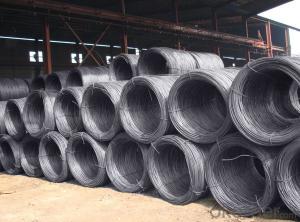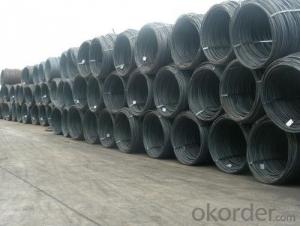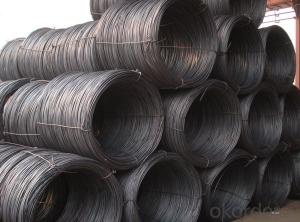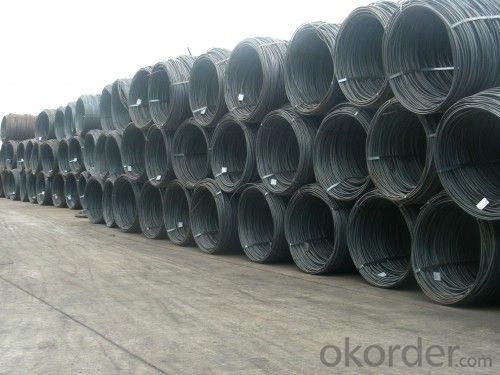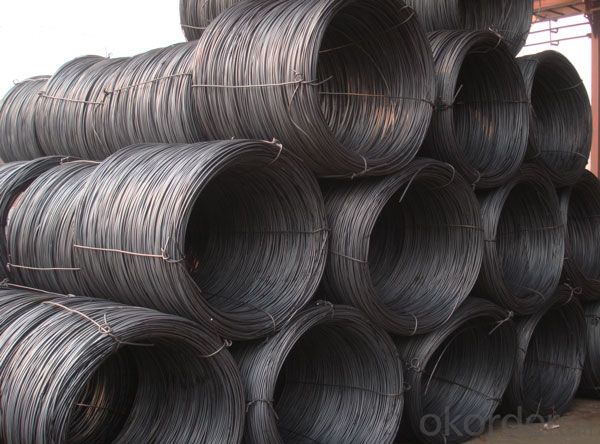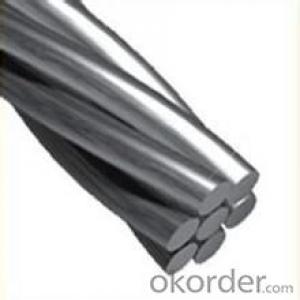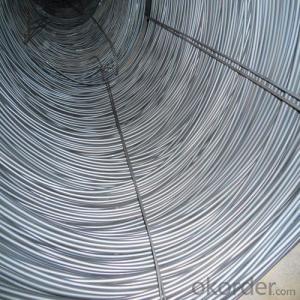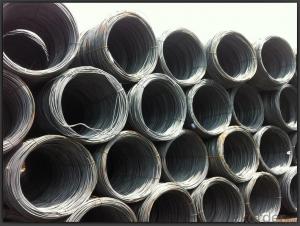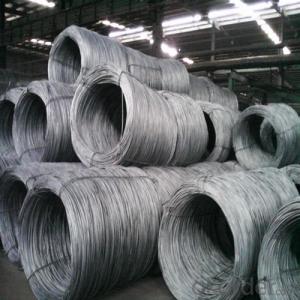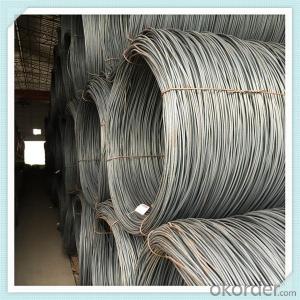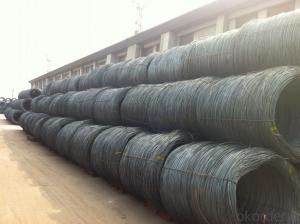Wire Rod High Quality Hot Rolled SAE1008 SAE1006
- Loading Port:
- Tianjin
- Payment Terms:
- TT OR LC
- Min Order Qty:
- 25 m.t.
- Supply Capability:
- 2000000 m.t./month
OKorder Service Pledge
OKorder Financial Service
You Might Also Like
Specification
Product Description:
OKorder is offering Wire Rod High Quality Hot Rolled SAE1008 SAE1006 at great prices with worldwide shipping. Our supplier is a world-class manufacturer of steel, with our products utilized the world over. OKorder annually supplies products to European, North American and Asian markets. We provide quotations within 24 hours of receiving an inquiry and guarantee competitive prices.
Product Applications:
Wire Rod High Quality Hot Rolled SAE1008 SAE1006 shaped into coil and delivery as finished product, including round, square, rectangular, hexagonal and so on. Since most of the products are round, it is generally called wire rod. Carbon steel wire rod is widely used in construction and manufacturing. Carbon steel wire rod is mainly used for reinforcement of reinforced concrete and welded structure or reprocessed (roberts , nail, etc.) materials, especially used to produce wire drawing, welding electrode, nails, spring, electronic, precise machinery parts and so on.
Product Advantages:
Wire Rod High Quality Hot Rolled SAE1008 SAE1006 are durable, strong, and resist corrosion.
Main Product Features:
· Premium quality
· Prompt delivery & seaworthy packing (30 days after receiving deposit)
· Corrosion resistance
· Can be recycled and reused
· Mill test certification
· Professional Service
· Competitive pricing
Product Specifications:
Manufacture: Hot rolled
Grade: SAE1008 SAE 1006
Certificates: ISO, SGS, BV, CIQ
Diameter: 5.5mm, 6.5mm, 7mm,8mm,9mm,10mm,12mm,14mm, as per customer request
Packaging: Export packing, nude packing, bundled
Grade | Chemical Composition (%) | |||||
C | Mn | S | P | Si | B | |
SAE1008B | 0.10max | 0.32max | 0.045max | 0.040max | 0.30max | 0.0008min |
Mechanical properties | ||||||
Yield strength(N/mm2) | Tensile strength(N/mm2) | Elongation (%) | ||||
≥195 | 350-380 | ≥32 | ||||
FAQ:
Q1: Why buy Materials & Equipment from OKorder.com?
A1: All products offered byOKorder.com are carefully selected from China's most reliable manufacturing enterprises. Through its ISO certifications, OKorder.com adheres to the highest standards and a commitment to supply chain safety and customer satisfaction.
Q2: How do we guarantee the quality of our products?
A2: We have established an advanced quality management system which conducts strict quality tests at every step, from raw materials to the final product. At the same time, we provide extensive follow-up service assurances as required.
Q3: How soon can we receive the product after purchase?
A3: Within three days of placing an order, we will begin production. The specific shipping date is dependent upon international and government factors, but is typically 7 to 10 workdays.
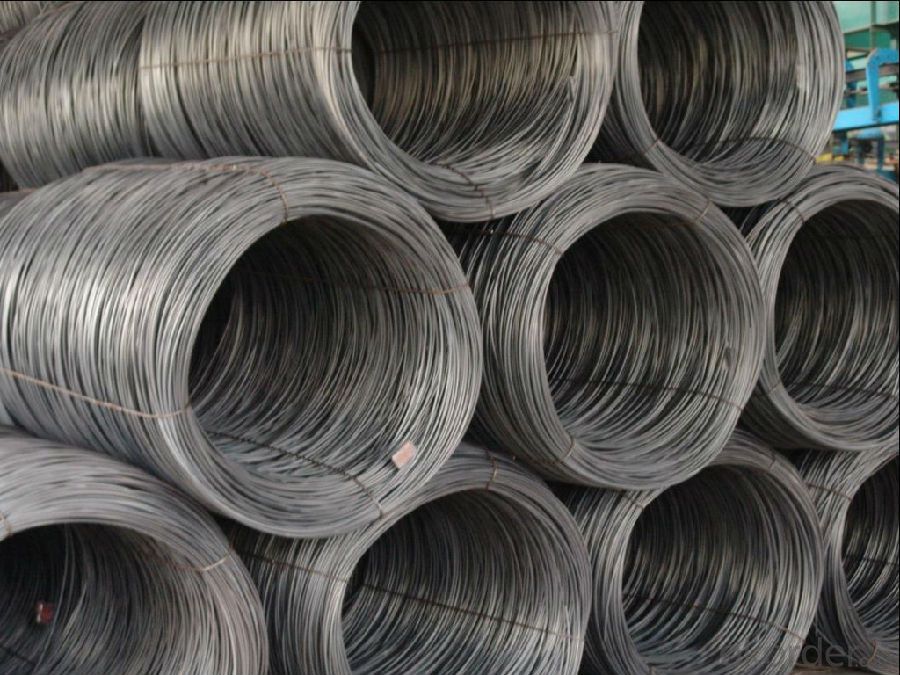
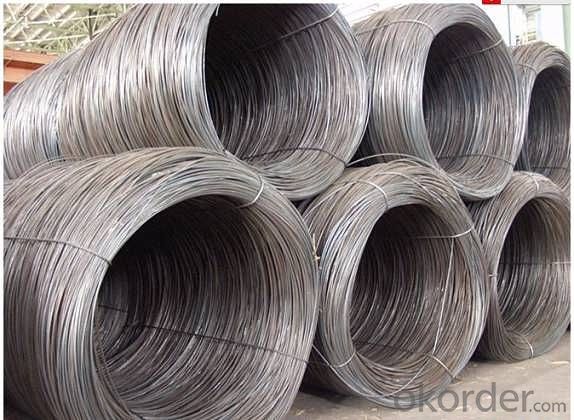
- Q: How is steel wire rod used in the manufacturing of wire forms for lighting fixtures?
- Steel wire rod is an essential component in the manufacturing of wire forms for lighting fixtures. The wire rod is primarily used as the raw material for creating various wire forms such as hooks, frames, and brackets that are integral to the structure and functionality of lighting fixtures. To begin with, the steel wire rod is first processed through a series of manufacturing steps. This typically involves the wire rod being drawn through a series of dies to reduce its diameter and increase its length. This process is known as wire drawing and results in a wire that is smooth, uniform, and of the desired thickness. Once the wire has been drawn, it is then further processed to create the specific wire forms required for lighting fixtures. This may involve bending, shaping, and cutting the wire to the desired dimensions. Various tools and equipment, such as wire forming machines and presses, are utilized to achieve the desired shapes and sizes. The wire forms created from the steel wire rod are then incorporated into the production of lighting fixtures. For instance, hooks made from the wire forms are used to suspend the fixtures from the ceiling or wall mountings. Frames made from the wire forms provide structural support and hold the components of the lighting fixture in place. Brackets made from the wire forms are used to attach the fixture to the wall or ceiling. Additionally, the wire forms made from steel wire rod are often used to create decorative elements in lighting fixtures. These can include intricate designs and patterns that enhance the aesthetics of the fixture. The wire forms can be shaped into various curves, loops, and spirals to create visually appealing and unique lighting designs. Overall, steel wire rod is an essential material in the manufacturing of wire forms for lighting fixtures. It provides the necessary strength, durability, and versatility required for creating functional and visually appealing lighting fixtures.
- Q: How are surface defects in steel wire rod repaired?
- Surface defects in steel wire rod can be repaired by various methods such as grinding, peeling, or machining. These processes involve removing the defective area, exposing the sound material beneath, and then reshaping or refinishing the surface to restore its integrity. Additionally, heat treatment processes like annealing can be employed to further enhance the mechanical properties of the repaired wire rod.
- Q: How does the corrosion resistance of steel wire rod vary with different wire drawing processes?
- The corrosion resistance of steel wire rod can vary with different wire drawing processes. Factors such as the surface finish, the presence of residual stress, and the alteration of the microstructure during the drawing process can influence the corrosion resistance of the wire rod. For example, wire rods that undergo a high-quality wire drawing process with proper cleaning and lubrication techniques can have improved corrosion resistance compared to those subjected to a less controlled or inadequate drawing process. Additionally, the wire drawing process can affect the formation of oxide layers on the surface of the wire rod, which can further impact its corrosion resistance. Overall, the specific wire drawing process employed can significantly impact the corrosion resistance of steel wire rod.
- Q: How is steel wire rod used in the manufacturing of wire for paper clips?
- Steel wire rod is used in the manufacturing of wire for paper clips because it serves as the raw material for producing the wire. The steel wire rod is drawn through a series of dies to reduce its diameter and shape it into the desired size and form for paper clip production. This process ensures that the wire is strong, flexible, and durable enough to hold papers together effectively.
- Q: What are the main factors influencing the choice of steel wire rod quality standards?
- The main factors influencing the choice of steel wire rod quality standards are: 1. Application requirements: The intended use of the steel wire rod plays a significant role in determining the quality standards. Different industries have specific requirements for strength, durability, corrosion resistance, and other mechanical properties. The choice of quality standards depends on meeting these application-specific needs. 2. National and international regulations: Steel wire rod quality standards are often regulated by national and international bodies such as ASTM (American Society for Testing and Materials), ISO (International Organization for Standardization), and EN (European Norms). Compliance with these standards is essential to ensure that the steel wire rod meets the necessary safety and performance requirements. 3. Customer specifications: Customers may have their own specific quality standards or requirements that need to be met. These specifications can include chemical composition, mechanical properties, surface finish, and dimensional tolerances. Meeting these customer specifications is crucial to ensuring customer satisfaction and maintaining long-term business relationships. 4. Quality assurance and control: Manufacturers and suppliers of steel wire rod often have their own internal quality assurance and control processes. These processes may include inspections, testing, and certifications to ensure that the wire rod meets the required quality standards. The choice of quality standards is influenced by the manufacturer's ability to meet these internal quality control measures. 5. Cost considerations: The choice of steel wire rod quality standards can also be influenced by cost considerations. Higher quality standards may require more stringent manufacturing processes, testing, and inspections, which can result in higher production costs. Manufacturers and customers need to strike a balance between quality and cost to ensure competitiveness in the market. Overall, the main factors influencing the choice of steel wire rod quality standards are application requirements, national and international regulations, customer specifications, quality assurance and control processes, and cost considerations. By considering these factors, manufacturers and customers can select the appropriate quality standards to meet their specific needs and ensure the desired performance and reliability of the steel wire rod.
- Q: How are steel wire rods used in the production of wire hangers for hanging clothes?
- Wire hangers for hanging clothes require steel wire rods as a vital component. These rods are typically made from high-quality, durable steel, which provides the necessary strength and rigidity to support the weight of garments. To create the hangers, the first step in the production process involves cutting the steel wire rods to the desired length. This can be done using specialized machinery or manual cutting methods. Once cut, the rods are then bent into the familiar hanger shape, usually with a combination of automated bending machines and skilled workers. The steel wire rods are shaped to form the top hook of the hanger, allowing it to be hung on a closet rod or other hanging mechanisms. Additionally, the rods are bent to create the curved body of the hanger, which provides a secure and stable structure for hanging clothes. After the basic shape of the hanger is formed, the steel wire rods may undergo further processes to enhance their functionality and appearance. This could involve coating the rods with a layer of protective material, such as plastic or vinyl, to prevent rusting and create a smooth surface for delicate fabrics. The hangers can also be painted or coated with various colors or finishes to match different branding or aesthetic preferences. In conclusion, steel wire rods are indispensable in the production of wire hangers for hanging clothes. Their strength, durability, and versatility make them an ideal material for creating hangers capable of supporting a wide range of garments. Whether in homes, retail stores, or laundry facilities, wire hangers made from steel wire rods are a staple tool for organizing and displaying clothes.
- Q: What is the manufacturing process of steel wire rod?
- The manufacturing process of steel wire rod involves several steps. First, steel billets are heated in a furnace to a specific temperature and then rolled through a series of rolling mills to reduce their thickness and shape them into long, continuous rods. These rods are then cooled and treated to improve their mechanical properties. Finally, the rods are cut to the desired length and undergo various finishing processes such as surface cleaning, coating, and packaging before being ready for sale or further processing into various steel wire products.
- Q: What are the typical chemical compositions of steel wire rod?
- The chemical compositions of steel wire rods can differ depending on the grade and intended use of the wire rod. However, iron (Fe) and carbon (C) are the most prevalent elements in steel wire rods. The carbon content in steel wire rods typically ranges from 0.05% to 0.85%. Apart from iron and carbon, other elements are frequently incorporated into steel wire rods to enhance specific properties. These elements include manganese (Mn), silicon (Si), sulfur (S), phosphorus (P), and occasionally chromium (Cr), nickel (Ni), and copper (Cu). Manganese is commonly added to improve the strength and hardenability of the wire rod. Silicon is added to boost the steel's resistance to oxidation and enhance its electrical properties. Sulfur and phosphorus are impurities that are usually limited to low levels due to their detrimental effects on the steel's ductility and toughness. Chromium, nickel, and copper are sometimes introduced to steel wire rods to enhance their corrosion resistance or improve specific mechanical properties. These elements are often found in stainless steel wire rods, which are used in applications that require high resistance to corrosion. It is important to note that the precise chemical composition of steel wire rods may vary depending on the steelmaking process and the presence of additional alloying elements or impurities. Therefore, it is crucial to consult the manufacturer's specifications or standards to determine the exact chemical composition of a particular steel wire rod.
- Q: What is a steel wire rod?
- It is a kind of round steel produced in the traditional double rolling mill and modern high-speed wire mill, mainly used in the construction industry and the raw material of deep processing. The material is mainly made of Q235/195/215 and other low, medium and high carbon steel
- Q: How is steel wire rod used in the manufacturing of wire mesh for concrete reinforcement?
- The production of wire mesh for concrete reinforcement relies heavily on steel wire rod. Wire mesh, which consists of interconnected steel wires in a grid-like structure, is responsible for improving the strength and durability of concrete structures. To create the wires needed for the mesh, steel wire rod is used as the main material. Typically made from carbon steel, the rod undergoes several processes to achieve the desired wire diameter and tensile strength. These processes involve hot rolling, pickling, and drawing. Once the steel wire rod has been transformed into wire, it is then shaped into a mesh pattern through either weaving or welding. The mesh pattern can vary and commonly includes square or rectangular openings. The spacing between the wires is determined based on the specific requirements of the concrete project. Throughout the manufacturing process, the wire mesh is designed with great care to reinforce concrete structures. When concrete is poured, the wire mesh is placed within it, forming a network of interconnected wires that evenly distribute the load. This reinforcement greatly enhances the concrete's ability to withstand stress, such as heavy loads or temperature changes, and reduces the likelihood of cracking or breaking. Furthermore, wire mesh also helps control shrinkage and prevents the formation of large cracks in the concrete. By limiting the movement of individual concrete elements, the mesh ensures that any cracks that do occur are smaller and easier to manage. In conclusion, steel wire rod plays a critical role in the production of wire mesh for concrete reinforcement. It is transformed into wire and then shaped into a mesh pattern through weaving or welding. This mesh is then incorporated into concrete structures to enhance their strength, durability, and resistance to cracking and breaking.
Send your message to us
Wire Rod High Quality Hot Rolled SAE1008 SAE1006
- Loading Port:
- Tianjin
- Payment Terms:
- TT OR LC
- Min Order Qty:
- 25 m.t.
- Supply Capability:
- 2000000 m.t./month
OKorder Service Pledge
OKorder Financial Service
Similar products
Hot products
Hot Searches
Related keywords
